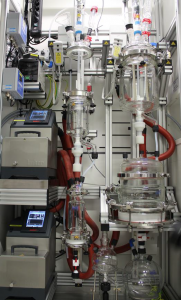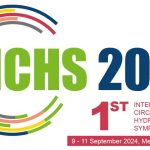Selective Ammoniacal Extraction Process for Valorizing Zn-rich BOF Sludges (SAMEX)
BOF sludges
For each million tonne of steel ArcelorMittal (AM) produces, it also generates on average 10,000 tonne of zinc-rich, fine Basic Oxygen Furnace (BOF) steelmaking sludge. In contrast with the coarse BOF sludge fraction, which is already internally recycled by ArcelorMittal via the sinter plant and then to the Blast Furnace, the fine BOF sludge fraction cannot be fed to the Blast Furnace (BF), as the zinc content would lead to prohibitive refractory failure and disturbances in the BF process. As a result, ArcelorMittal either internally stores these sludges or is forced to landfill them.
Ammoniacal leaching process

SOLVOMET KU Leuven Leaching Reactors
To avoid excessive landfilling and to create an industrial symbiosis system, ArcelorMittal developed in 2017-2018, in collaboration with SOLVOMET KU Leuven, an ammoniacal leaching process.
This was first done on lab-scale and, subsequently, upscaled to a small pilot level (TRL5). The piloting activities were performed in SOLVOMET KU Leuven’s leaching reactors of 1L & 5L.
The developed process (which was published in the Journal of Sustainable Metallurgy, see Open Access link here: URL) selectively extracts zinc from the sludge (obtaining a 76% leaching yield) while leaving behind most iron. The cleaned, iron-rich residue can be fed to the BF, via the sinter plant, representing major iron cost savings.
Concurrently, the leached zinc in the pregnant leach solution can be recovered as a zinc sulphide-precipitate product, as a feed for the zinc industry.
SAMEX: upscaling, validation and replication
In the SAMEX project, Tecnalia (Spain), ArcelorMittal (Spain) and KU Leuven (Belgium) shall upscale the ammoniacal leaching process to TRL7, aiming to engineer and build a pilot plant.
This pilot plant will consist of several units: (a) dewatering (incl. filter pressing), (b) leaching reactor incl. air injection, (c) solid/liquid (filter press) separation, (d) ZnS precipitation). The lixiviants will be regenerated. The pilot plant will be used to demonstrate and validate the flowsheet, using distinct BOF sludges from different ArcelorMittal plants in Europe.
If successful, ArcelorMittal foresees to implement the process in at least one third of its EU-plants by 2025 (i.e. treatment of 120,000 tonne/year BOF fine sludge). Furthermore, other sludge producers and steelmaking companies will be able to benefit from the results generated in the project.







